Une partie des informations de ce site Web a été fournie par des sources externes. Le gouvernement du Canada n'assume aucune responsabilité concernant la précision, l'actualité ou la fiabilité des informations fournies par les sources externes. Les utilisateurs qui désirent employer cette information devraient consulter directement la source des informations. Le contenu fourni par les sources externes n'est pas assujetti aux exigences sur les langues officielles, la protection des renseignements personnels et l'accessibilité.
L'apparition de différences dans le texte et l'image des Revendications et de l'Abrégé dépend du moment auquel le document est publié. Les textes des Revendications et de l'Abrégé sont affichés :
| (12) Brevet: | (11) CA 2128401 |
|---|---|
| (54) Titre français: | ROBINET A PAPILLON |
| (54) Titre anglais: | BUTTERFLY VALVE ASSEMBLY |
| Statut: | Périmé et au-delà du délai pour l’annulation |
| (51) Classification internationale des brevets (CIB): |
|
|---|---|
| (72) Inventeurs : |
|
| (73) Titulaires : |
|
| (71) Demandeurs : |
|
| (74) Agent: | BORDEN LADNER GERVAIS LLP |
| (74) Co-agent: | |
| (45) Délivré: | 2000-05-23 |
| (22) Date de dépôt: | 1994-07-19 |
| (41) Mise à la disponibilité du public: | 1995-01-24 |
| Requête d'examen: | 1996-05-08 |
| Licence disponible: | S.O. |
| Cédé au domaine public: | S.O. |
| (25) Langue des documents déposés: | Anglais |
| Traité de coopération en matière de brevets (PCT): | Non |
|---|
| (30) Données de priorité de la demande: | ||||||
|---|---|---|---|---|---|---|
|
A valve of the type for controlling engine coolant flow to a heater core
having a resilient butterfly valve formed of thermoplastic elastomeric
material.
The outer periphery is sufficiently resilient to absorb actuator overtravel in
the
seated condition. The butterfly has formed integrally therewith a central hub
with torque-transmitting surfaces molded therein and a pair of oppositely
disposed stiffeners extend outwardly from the hub in the central region of the
butterfly. Assembly is simplified by placing the butterfly in the body and
inserting a winged actuator shaft through journal holes in the body into the
butterfly hub such that the wings on the shaft engage the torque-transmitting
surfaces in the hub.
Note : Les revendications sont présentées dans la langue officielle dans laquelle elles ont été soumises.
Note : Les descriptions sont présentées dans la langue officielle dans laquelle elles ont été soumises.

2024-08-01 : Dans le cadre de la transition vers les Brevets de nouvelle génération (BNG), la base de données sur les brevets canadiens (BDBC) contient désormais un Historique d'événement plus détaillé, qui reproduit le Journal des événements de notre nouvelle solution interne.
Veuillez noter que les événements débutant par « Inactive : » se réfèrent à des événements qui ne sont plus utilisés dans notre nouvelle solution interne.
Pour une meilleure compréhension de l'état de la demande ou brevet qui figure sur cette page, la rubrique Mise en garde , et les descriptions de Brevet , Historique d'événement , Taxes périodiques et Historique des paiements devraient être consultées.
| Description | Date |
|---|---|
| Le délai pour l'annulation est expiré | 2010-07-19 |
| Lettre envoyée | 2009-07-20 |
| Accordé par délivrance | 2000-05-23 |
| Inactive : Page couverture publiée | 2000-05-22 |
| Inactive : Taxe finale reçue | 2000-02-22 |
| Préoctroi | 2000-02-22 |
| Un avis d'acceptation est envoyé | 1999-09-22 |
| Un avis d'acceptation est envoyé | 1999-09-22 |
| Lettre envoyée | 1999-09-22 |
| Inactive : Renseign. sur l'état - Complets dès date d'ent. journ. | 1999-09-16 |
| Inactive : Dem. traitée sur TS dès date d'ent. journal | 1999-09-16 |
| Inactive : Approuvée aux fins d'acceptation (AFA) | 1999-07-27 |
| Exigences pour une requête d'examen - jugée conforme | 1996-05-08 |
| Toutes les exigences pour l'examen - jugée conforme | 1996-05-08 |
| Demande publiée (accessible au public) | 1995-01-24 |
Il n'y a pas d'historique d'abandonnement
Le dernier paiement a été reçu le 1999-06-14
Avis : Si le paiement en totalité n'a pas été reçu au plus tard à la date indiquée, une taxe supplémentaire peut être imposée, soit une des taxes suivantes :
Les taxes sur les brevets sont ajustées au 1er janvier de chaque année. Les montants ci-dessus sont les montants actuels s'ils sont reçus au plus tard le 31 décembre de l'année en cours.
Veuillez vous référer à la page web des
taxes sur les brevets
de l'OPIC pour voir tous les montants actuels des taxes.
| Type de taxes | Anniversaire | Échéance | Date payée |
|---|---|---|---|
| TM (demande, 3e anniv.) - générale | 03 | 1997-07-21 | 1997-06-25 |
| TM (demande, 4e anniv.) - générale | 04 | 1998-07-20 | 1998-06-25 |
| TM (demande, 5e anniv.) - générale | 05 | 1999-07-19 | 1999-06-14 |
| Taxe finale - générale | 2000-02-22 | ||
| TM (brevet, 6e anniv.) - générale | 2000-07-19 | 2000-06-22 | |
| TM (brevet, 7e anniv.) - générale | 2001-07-19 | 2001-06-20 | |
| TM (brevet, 8e anniv.) - générale | 2002-07-19 | 2002-06-18 | |
| TM (brevet, 9e anniv.) - générale | 2003-07-21 | 2003-06-18 | |
| TM (brevet, 10e anniv.) - générale | 2004-07-19 | 2004-06-18 | |
| TM (brevet, 11e anniv.) - générale | 2005-07-19 | 2005-06-20 | |
| TM (brevet, 12e anniv.) - générale | 2006-07-19 | 2006-06-16 | |
| TM (brevet, 13e anniv.) - générale | 2007-07-19 | 2007-06-07 | |
| TM (brevet, 14e anniv.) - générale | 2008-07-21 | 2008-06-18 |
Les titulaires actuels et antérieures au dossier sont affichés en ordre alphabétique.
| Titulaires actuels au dossier |
|---|
| EATON CORPORATION |
| Titulaires antérieures au dossier |
|---|
| DENNIS RAY CARLS |
| JAMES EUGENE PEARSON |